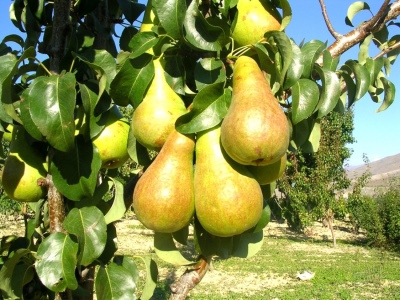
- Authors: Yu.A. Petrov, N.V. Efimova (VSTISP)
- Appeared when crossing: interspecific hybrid No. 3 x Josephine Mechelnaya
- Year of approval: 2001
- Fruit weight, g: 100-140
- Ripening terms: autumn
- Fruit picking time: from mid-September to early October
- Appointment: universal
- Growth type: medium height
- Yield: high
- Height, m: 5 to 7
The pear occupies only 2% of all fruit trees that are grown in the regions of central Russia. Among the variety of species of such a culture, the Vernaya pear is especially prominent, which pleases gardeners with tasty and juicy fruits.
Breeding history
The faithful were bred by domestic breeders Yu. A. Petrov, N. V. Efimov. For the first time, the variety was registered by scientists in 1958, and only in 1998 began tests on planting pears. Vernaya was included in the State Register in 2001.
Description of the variety
Pear Vernaya belongs to the group of autumn varieties, grows well in the regions of the Moscow region, giving out fruits from September to October. Trees of small height are covered with an asymmetrical and drooping crown with dark green leaves. The flowers are small, have a white tint and a pronounced aroma.
Fruit characteristics
The variety pleases with small fruits, the average weight of which reaches 140 g. The shape of the pears is correct, the color is rich yellow-green with a slight blush on the surface. Fruits reach ripeness around the end of September, they can grow until the beginning of October.
Taste qualities
The fruit of Vernaya has a dense, creamy color and grainy texture. Pears attract with a light fruity aroma, their taste is sweet with a slight sour aftertaste.
Ripening and fruiting
The variety begins to bear fruit 4 years after planting. Subsequently, the tree will bear fruit every year, bearing generous harvests.

Yield
A small tree has fairly high yields. Up to 40 kg of fruit can be harvested from one tree per season. At the same time, pears are notable for good keeping quality, which allows you to organize safe transportation and ensure storage of fruits from 60 to 65 days.
Self-fertility and the need for pollinators
Faithful cannot self-pollinate, it is necessary to have pollinating varieties nearby.
Landing
Before planting a pear, you must pay special attention to the seedling. Only strong and healthy bushes without broken or dry branches can take root in the regions of Russia. Gardeners recommend giving preference to seedlings with a closed root system. In order for the culture to quickly take root and begin to grow actively, it is worth considering a few tips:
- to improve air and water exchange in the soil, its shallow loosening in the near-trunk circle will help;
- every year it is necessary to carry out pest control in the form of preventive and therapeutic treatment;
- pruning will help shape the crown and extend the life of the tree.
Pear Vernaya is resistant to frost, but in winter it is recommended to sprinkle the trunk circle with a mixture of humus and soil. You can also cover the trunks of young seedlings during frost with protective material.


Growing and care
The pear is not demanding on the soil, however, it is better to choose drainage and fertile soils, since the tree does not tolerate stagnant moisture well. Also, do not plant the tree in shaded areas. Crop care includes standard actions on the part of the gardener:
- watering;
- pruning;
- loosening;
- preventive spraying;
- rejuvenation of the crown.
Before planting a seedling, the dug hole must be fertilized. Inside you can put:
- humus;
- ammonium nitrate;
- superphosphates;
- ash;
- potassium.
The optimal watering frequency is 4–5 times a month. In this case, during watering, you must use a bucket of water in the morning and evening. Gardeners are advised to adjust the volume of water depending on the weather conditions.



Disease and pest resistance
The variety has good immunity to scab, but violation of the rules can lead to a number of not the most pleasant diseases. Among the common ones:
- moniliosis;
- sooty fungus;
- powdery mildew;
- black cancer;
- rust of leaves;
- stem rot;
- brown leaf spot.
All of these diseases damage the harvest and reduce the productivity of the tree, leading to its rapid aging. Also, the pear is threatened by rodents, insect pests. To increase the immunity of a variety, it is worth taking several measures.
- Biological. This means the timely introduction of organic fertilizers in the form of manure, compost. You can also use herbal teas.
- Agrotechnical. Improves the growth and development of the tree. Activities include choosing the optimal planting site, regularly pruning and harvesting seedlings.
- Chemical. In spring and autumn, the tree should be sprayed to prevent disease and pests.
- Physical and mechanical. If a disease is found on the branches and leaves, the affected elements must be removed and burned to prevent the spread of the infection.
Errors in the care of the variety can also worsen the immunity of the pear. Therefore, do not neglect watering, feeding and pruning.

Like any other fruit trees, the pear needs protection from various diseases and pests. When planting a pear on your site, you need to know in advance what diseases you should beware of. To successfully carry out the struggle, it is necessary first to correctly identify the cause of the problem.It is important to distinguish signs of disease from manifestations of the presence of insects, mites, caterpillars and other types of pests.





































































